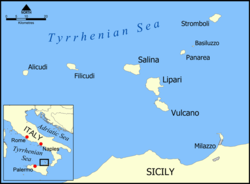Vulcano
Vulcano is a small volcanic island in the Tyrrhenian Sea, about 25 km north of Sicily and the southernmost of the Aeolian Islands. It is 21 square kilometres in area, rises to 499 metres, and contains several volcanic centres, including one of four active non-submarine volcanos in Italy and the formerly separate islet of Vulcanello.
History
The Greek wind god Aeolus was said to have lived on this island, then called Hierà. The name for the entire Aeolian Island chain descended from the mythical residence of Aeolus. The Roman name for the island Vulcano has contributed the word for volcano in most modern European languages. The Romans used the island mainly for raw materials, harvesting wood and mining alum and sulfur. This was the principal activity on the island until the end of the 19th Century.
When the Bourbon rule collapsed in 1860 (see Francis II of the Two Sicilies) a British man named James Stevenson bought the northern part of the island, built a villa, reopened the local mines and planted vineyards for grapes that would later be used to make Malvasia wine. Stevenson lived on Vulcano until the last major eruption on the island, in 1888. The eruption lasted the better part of two years, by which time Stevenson had sold all of his property to the local populace, and never returned to the island. The villa is still intact.
Currently, around 470 people live on the island, mainly deriving their income from tourism. It is a few minutes hydrofoil ride from Lipari and has several hotels and cafes, the important attractions being the beaches, hot springs and sulfur mud baths.
Geology
The volcanic activity in the region is largely the result of the northward-moving African Plate meeting the Eurasian Plate. There are three volcanic centres on the island:
- At the southern end of the island are old stratovolcano cones, Monte Aria (500 m), Monte Saraceno (481 m) and Monte Luccia (188 m), which have partially collapsed into the Il Piano Caldera.
- The most recently active centre is the Gran Cratere at the top of the Fossa cone, the cone having grown in the Lentia Caldera in the middle of the island, and has had at least 7 major eruptions in the last 6000 years.
- At the north of the island is Vulcanello, 123 metres high, and is connected to the rest of it by an isthmus which is flooded in bad weather. It emerged from the sea during an eruption in 183 BC as a separate islet. Occasional eruptions from its three cones with both pyroclastic flow deposits and lavas occurred from then until 1550, the last eruption creating a narrow isthmus connecting it to Vulcano. Vulcano has been quiet since the eruption of the Fossa cone on August 3 1888 to 1890, which deposited about 5 metres of pyroclastic material on the summit. The style of eruption seen on the Fossa cone is called a Vulcanian eruption, being the explosive emission of pyroclastic fragments of viscous magmas caused by the high viscosity preventing gases from escaping easily.
Mythology
The Romans believed that Vulcano was the chimney to the god Vulcanus's workshop. The island had grown due to his periodic clearing of cinders and ashes from his forge. The earthquakes that either preceded or accompanied the explosions of ash etc., were considered to be due to Vulcanus making weapons for Mars and his armies to wage war.
Expulsion of lava is a rare feature of vulcanian eruptions and always occur at the end of the eruption.
Since Roman times similar features on Earth have been known as volcans - volcanes and volcanoes. It is also used in connection with similar features on the Moon, Mars, Venus and Mercury and other stellar bodies. Some purists argue that the name should be vulcans, vulcanes and vulcanoes.
The Romans gave the word to the world and with it came ashes, cinders, lava - "flows."
[1] His workshop is also reputed to have been at either Mount Etna or Mount Olympus.


